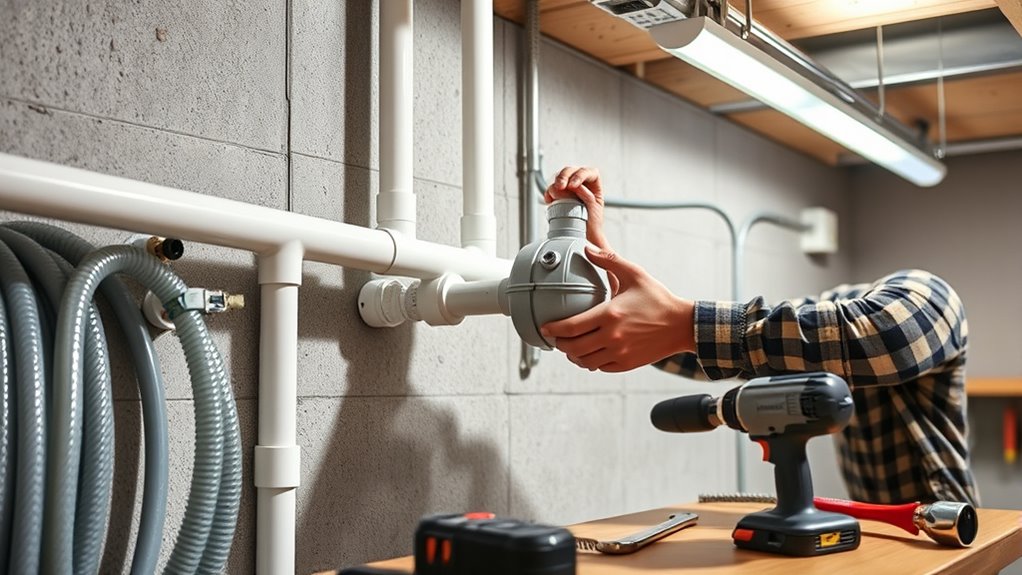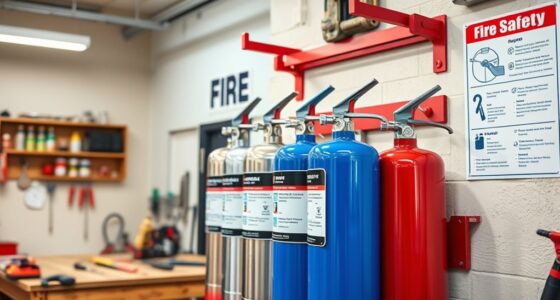To install a central vacuum system, start by planning the pipe layout throughout your home, making sure outlets are strategically placed in high-traffic areas. Choose a power unit with enough horsepower for your home’s size and debris level, then securely connect the pipes behind walls, ensuring tight seals. Proper installation and placement of outlets maximize efficiency, while regular maintenance keeps the system running smoothly. Keep exploring to discover detailed steps that will help you set up your system with confidence.
Key Takeaways
- Plan the pipe layout to cover main cleaning areas, hiding pipes behind walls for a tidy appearance.
- Select a power unit with appropriate horsepower and noise level for your home’s size and preferences.
- Install outlets strategically in frequently cleaned rooms for easy access during vacuuming.
- Connect and seal all pipe sections securely, ensuring proper slopes and connections to prevent leaks.
- Perform regular maintenance by checking for blockages, emptying canisters, and cleaning the system for optimal performance.

Installing a central vacuum system can substantially improve your home’s cleanliness and convenience. Once you set it up, you’ll notice how much easier it becomes to clean your space without lugging around a heavy vacuum cleaner. The core components of this system include a power unit and a network of vacuum pipes that run through your walls, connecting to outlets in various rooms. The power unit, typically installed in a garage, basement, or utility closet, acts as the engine that creates the suction needed to pick up dirt and debris. When you plug the hose into a wall outlet, the system activates, and the vacuum pipe network channels the suction directly to wherever you’re cleaning.
Installing a central vacuum system enhances cleanliness and ease of use throughout your home.
The vacuum pipe is essential because it forms the physical pathway for dirt to travel from your cleaning tools to the power unit. You’ll want to choose a system with durable, smooth-walled pipes that minimize airflow resistance. Proper installation ensures these pipes are hidden behind walls, keeping your space tidy and unobstructed. The piping layout should be designed to cover all the main areas you intend to clean, with strategically placed outlets to make cleaning efficient and easy. As you install the vacuum pipe, pay attention to the pipe’s slope and connections to prevent leaks or blockages that could reduce suction power.
The power unit needs to be powerful enough to handle the size of your home and the volume of debris you expect to collect. Typically, a higher horsepower rating translates to stronger suction, which ensures thorough cleaning on carpets, hardwood floors, and other surfaces. When selecting a power unit, consider noise levels as well—some models are designed to operate quietly, so they won’t disturb your household. Installing the power unit in a convenient yet out-of-the-way location makes maintenance easier and minimizes noise disturbance.
As you set up the system, you’ll connect the vacuum pipe network to the power unit, ensuring all sections are secure and sealed. Once installed, you’ll enjoy the benefits of quick and effortless cleaning, with the ability to switch outlets easily without lugging your vacuum around. Regular maintenance, like emptying the canister or bag and checking for blockages in the pipe network, will keep your system running smoothly. Additionally, understanding self water management principles can help in optimizing your home’s overall cleaning and maintenance routines. Overall, a well-installed central vacuum system offers a seamless cleaning experience, saving you time and effort while maintaining a healthier home environment.
Frequently Asked Questions
Can I Install a Central Vacuum System Myself Without Professional Help?
You can attempt a DIY installation of a central vacuum system if you’re comfortable with plumbing and electrical work. You’ll need basic tool requirements like a drill, pipe cutter, and level. Follow detailed instructions carefully, plan your pipe routes, and guarantee proper sealing. However, if you’re unsure or uncomfortable with these tasks, it’s safer to hire a professional to avoid mistakes that could affect your system’s performance.
What Is the Average Lifespan of a Central Vacuum Unit?
Did you know that central vacuum units typically last between 12 to 20 years? You can expect good vacuum durability and system longevity if you perform regular maintenance and choose quality models. Proper care prevents clogs and motor issues, extending the unit’s lifespan. Keep an eye on filter replacements and motor performance, and your system should serve you well for many years, making your investment worthwhile.
How Noisy Is a Central Vacuum Compared to Portable Models?
A central vacuum system is generally quieter than portable models, with a lower noise level that makes cleaning more comfortable. The sound comparison shows that central units often operate at around 60-70 decibels, similar to a normal conversation, whereas portable vacuums can reach 80-85 decibels or more. You’ll notice a significant reduction in noise, allowing you to clean without disturbing others in your home.
Are There Specific Brands Recommended for Durability and Performance?
Think of choosing a vacuum brand like selecting a reliable vehicle; some names stand out for durability and performance. For central vacuums, brands like CycloVac and VacuMaid often top the list, known for durability factors and consistent power. When comparing brands, consider customer reviews, warranty coverage, and build quality. These details help guarantee your system runs smoothly and lasts, just like a trusted car that keeps you moving forward.
What Maintenance Is Required to Keep the System Functioning Properly?
To keep your central vacuum system running smoothly, you should regularly replace the filter and perform duct cleaning. Check the filter every few months and replace it when it’s dirty to maintain suction power. Schedule duct cleaning annually to prevent dust buildup and guarantee peak airflow. These simple steps help prolong your system’s lifespan, improve cleaning efficiency, and keep your indoor air quality high.
Conclusion
Now, as you finish connecting the last pipe and hear the hum of your new system come to life, imagine the effortless cleanups ahead. With everything in place, a hidden power is ready to transform your home. But beware—once you experience the quiet strength of your central vacuum, you’ll wonder how you ever managed without it. The journey isn’t over; it’s just beginning. Are you ready to enjoy the spotless, fresh space that awaits?









